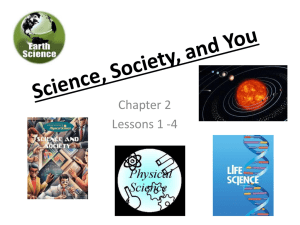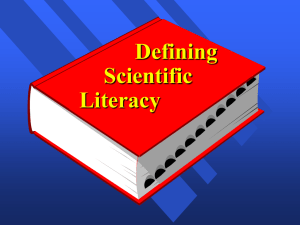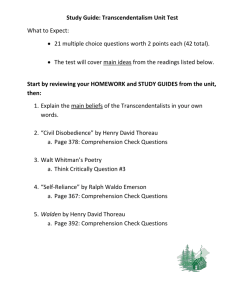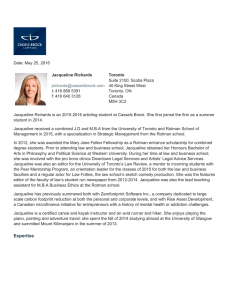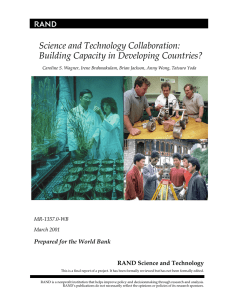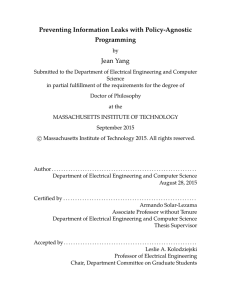Scientific Literacy - Tasker Milward Physics Website
advertisement
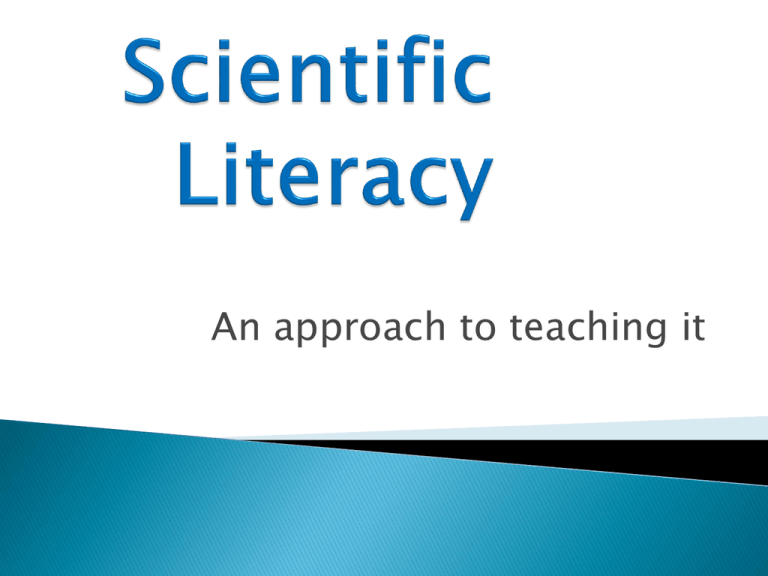
An approach to teaching it Jacqueline is purchasing her first car and feels torn as she balances conflicting desires and messages. She yearns to be seated behind the wheel of a stylish vehicle but is also confronted by advertising messages that claim "best fuel economy for your money!" and "great for the environment!“ With her modest budget, Jacqueline knows she must consider the cost of routine maintenance and fuel. She also cares about how the fuel emissions of different brands of cars will affect air quality and the environment. Every day, the need to make decisions related to science confronts young people. Although buying a car might seem to be a financial or lifestyle issue, the choice connects to environmental science. Fortunately, Jacqueline has practiced solving problems, analyzing data, and making informed, data-driven decisions in her science classes; and she understands that her decisions today can affect the environment she will live in tomorrow. We might say Jacqueline is critically literate in science, meaning she has the ability to read, write, think, and talk about real-world science issues (Lapp & Fisher, 2010). Over the last 10 years the OECD has developed and refined its definition of scientific literacy. It started off as: “………the capacity to use scientific knowledge, to identify questions and to draw evidence-based conclusions in order to understand and help make decisions about the natural world and the changes made to it through human activity.” (OECD, 2000, 2003). In 2006 scientific knowledge was split into two types “knowledge of science” and “knowledge about science” also included was the knowledge about the relationship between science and technology In 2015 “…….the ability to engage with science-related issues, and with the ideas of science, as a reflective citizen” has been added to the definition . The knowledge about science has been further split into procedural knowledge and epistemic knowledge. Finally, the contexts for assessment in PISA 2015 have been changed from ‘Personal, Social and Global’ in the 2006 Assessment to ‘Personal, Local/National and Global’ to make the headings more coherent. 3 What does being scientifically literate mean? It means being able to: Explain phenomena scientifically Including recognising, offer and evaluate explanations for a range of natural and technological phenomena Evaluate and design scientific enquiry Suggest ways of investigating questions which are asked scientifically, design experiments in a very scientific way and evaluate whether the experiments are fair, and lead to valid conclusions Interpret data and evidence scientifically Analyse and evaluate data, claims and arguments in a variety of representations and draw appropriate scientific conclusions. 4 Types of scientific knowledge Reasons why students may not be effective scientific readers: • Unfamiliar vocabulary • Reading age of the text too high compared to reading age of the average student. • Lack of wider subject knowledge that allows text to be put into context and linked to other topics. • Lack of confidence (or lack of a strategy) when making sense of data. Teach students to read like scientists. To develop deeper comprehension, it's not enough for students to merely have a piece of text to read. They must also develop the ability to read and think like scientists. This means developing strategies for reading scientific writing and building a deep understanding of related vocabulary. One of the best ways for teachers to help students learn how to comprehend a science text is to model the thinking that occurs while reading graphs, charts, data tables, and data analysis sections. Proficient science readers will read the text that correlates to a table of data, for example, and then study the table, looking for features like units of measure, data range values, and column titles. They will then look back at the text to reread, or continue reading, in an effort to connect this information to the text. More than just comprehension • Traditionally GCSE papers have always included questions that are at least in part comprehension based. • Students can be well trained to look at the information given in the question and pick out the word/sentence/item of data that answers the question. • They often struggle to spot the point at which the question begins to examine their wider knowledge and requires more than ‘spot the correct answer’. Getting students to ask questions of the text, not just answer questions about the text. As teachers, if we read a piece of text (with the intention of producing a comprehension type activity) then we are often looking out for some of the following: 1. Links between pieces of information in the text. 2. Links between the text and other areas of scientific knowledge that we can reasonably ask a question about. (Content knowledge) 3. Links between the text and its relation to wider aspects of scientific methods (procedural knowledge) or the wider impact of science (epistemic knowledge). 4. Data that can be used for calculation or evaluation. If we can train students to read text in this way then this is a significant step to improving their scientific literacy. Content knowledge – how does this link to my knowledge of other areas of science? Procedural knowledge – how does this link to how scientists use data to come up with new ideas? Name of topic here Epistemic knowledge – how does this link to the impact of science on the world? Data – how could the data given in the text be used to calculate new information? How could I check its reliability?
